
The First R.N. Battle of the Falklands
Written by Godfrey Dykes© RN Communications Branch Museum/Library
This is a story which all RN Sailors, past and present, Officer or Rating, should know about. It cannot of course be compared with the 1982 Falklands War, which will be remembered as much for the logistics of war as for the GUTSY and successful prosecution of the war. Nor do I seek to sideline the 1982 war in any way, for it is part of my heart and life, but, the truth is that the first R.N. Battle in the waters of the Falklands has no parallel or precedent.
This first section is really an introduction to the main story which starts further down the page. It should be read first so that you get a good understanding of the true significance of the main story.
Today's date is the 4th July 2004, a day/date which sees the Americans celebrate the winning of the War of Independence against the British in the latter part of the 18th century. Twenty two years ago, this day was one of several used in the Spring/Summer offensive of 1982 pursing the War against the Argentine who had forcibly taken the Falkland Islands from the British, the rightful owners. It was a splendid time in our recent history engulfing all of us serving in the navy at that time in many various ways, and can of course also be considered as a War of Independence fought for and on behalf of the Crown and the peoples indigenous to the Islands. On this occasion, the British were the victors.
In some cases, the subject is still quite raw and so much has been written and recorded for posterity that additional articles are quite superfluous. However, the other day I came upon a statistic which stunned me and I am sure it will you too, namely that the known data of 255 men losing their lives in this war, has been surpassed by 300 Falklands veterans who have committed suicide between 1982 and 2004. There are no words which can measure the profoundness of this tragic statement.
The 1982 story of the Falklands really starts with an observation made by HMS Endurance (Captain Barker R.N.), the only Royal Naval ship stationed in the South Atlantic. This led to a large naval unit being formed whose logistics stretched seven thousand miles from the UK. A battle ensued between the Royal Navy and the Argentine air force which bloodied the nose of the Royal Navy, losing several ships. The Argentine navy never saw or engaged the main task force but was itself attacked by a British nuclear submarine, Conqueror (Commander Wreford-Brown R.N., - international radio callsign GYJU)), whilst at sea to the west of the Royal Navy's presence. The attack destroyed an old WW2 ex USN cruiser, the General Belgrano {international radio callsign LORH} with considerable loss of life. Thereafter, the Argentine navy remained in harbour. The navy punched its way through and managed a successful amphibious assault on the Islands, losing more vessels in the process. The land war was short and decisive culminating in the defeat and humiliation of the mainly conscript Argentine army units. However, it was expensive, the cost being two hundred and fifty lives of our servicemen and many many more Argentine's. However, even our most sternest critics, marveled at our ability to mount such an operation over such huge distances and win, though bloodied we were.
Way back in 1914 (90 years ago) and still down off South America but on the Pacific Chilean coast line, we were again bloodied, this time by the German navy. However, to understand the story properly, for it is interwoven through many reference books, I need to tell you a little bit about Germany's territory outside the Vaterland (fatherland).
In 1898 Germany had leased from China for a period of ninety nine years (by diplomatic deceit) a tiny insignificant area/port in the far east, which itself was part of the Chinese province of Shantung situated in the Yellow Sea. The area/port was called Tsing-Tau a naval facility in the Kiau-Chau Bay: it is this latter name which history recognises. Kiau-Chau was the original base for the German Raider Emden which was destroyed by HMAS Sydney. China has undergone many changes since the Boxer Uprisings (prior to this event) and with cultural changes came name changes of their provinces, towns and cities. To help you orientate, the first image is a map of China in 1900 biased towards Kiau-Chau and the second image is of a modern map of china annotated in a similar manner.

Germany's aggression was legion in all parts of the world, and the Japanese feared that they would get up to their usual evil tricks, even though relatively small in numbers and facilities. The Japanese, being our ally, issued the KIAU CHAU camp an ultimatum which was that they should clear out of China and take all their warships out of the Pacific/Far East area. Germany had to comply by 3am London time on 23rd August 1914 or face direct war with Japan, just 500 odd miles away to the east. Germany had several overseas possession, but cherished this one above all others - it was 117 square miles with a fine harbour and fortified town, and since 1898 (sixteen years) had lavished untold amounts of money on building it up ready to use as a spring board to increase a foot hold in the Far East : they were not going to move. It was also known, though as yet unchecked by the Chinese, that Germany had already broken the lease agreement by taking over more Shantung territory than was intended. Kiau Chau was full of Germans and not just combatants, for many had fled there escaping the consequences of war in other parts of the Far East. They had an "Eastern Squadron" based there which comprised of two armoured cruisers, three light cruisers and some gunboats. Had hostilities broken out, she faced unimaginable odds with Britain's Far East Squadron being twice that size; the French with two armoured cruisers, Japan with at least twenty eight large battleships and cruisers including five Dreadnoughts, several flotillas of destroyers and submarines, plus the Russian input all ready for the kill. Germany had no submarines at Kiau Chau but were ready to mine every conceivable approach to their territory.
Predictably, Germany did not comply with the Japanese ultimatum. How could the Kaiser, who, upon taking on the lease, proclaimed to the world the infamous observation about the "mailed fist of Germany"; "that we are descendants of Attila and his Huns", and that "the time had come for the great German eagle to spread her wings," now back down to Japan?
Directly after the hour of compliance had elapsed, the Japanese navy started to bombard Kiau Chau. However, by that time a British ship, the destroyer HMS Kennet, had had an adventure in the neighbourhood of the Tsing-Tau forts when it sighted a German destroyer the 'S.90'. The Kennet gave chase but the destroyer escaping back to the safety of Kiau Chau brought the British destroyer too close to the German guns placed on the forts and had to allow the German to escape. The Kennet took several casualties.
After a great deal of effort in clearing mines and other preparations (which included a one hundred percent blockade of the port), of daily shellings, of aircraft bombings, of stormings by amphibious troops landing behind German lines (remember this territory is 117 square miles - a big area) which lasted for seventysix days after Japan had declared war, the forts and area of Tsing-Tau capitulated and the white flag was raised by the Germans. Four thousand and forty two Germans were taken prisoner, with nearly as many killed. Japan lost two hundred killed and the British, just twelve. The Kaiser and the whole of Germany were shattered and found it difficult to believe this severe loss of life, of equipment and of territory. The Japanese took command of Kiau Chau.
Germany continued to lose all her Pacific territories, one by one snatched from her by the Royal New Zealand Navy, the Royal Australian Navy, the British Navy and the French Navy. What armed cruisers had been based on many of these places escaped into the Pacific, and they, plus those who escaped from Kiau Chau, were always a potential hazard to the allies. It is to those 'roaming' German ships that I now turn my attention.
A group of heavily armed German cruisers, unshadowed and thought to have escaped from Kiau Chau before the Japanese hostilities began, out to disrupt allied shipping traffic, had crossed the Pacific on a south easterly course, ostensibly aiming for the Cape Horn area and rich pickings! When off Valparaiso, Chile, they came across an inferior British naval group comprising of two cruisers and an armed merchant ship. These were HMS Monmouth and HMS Glasgow plus the 'Otranto'. The resulting battle was a foregone conclusion as shown in the following pages.
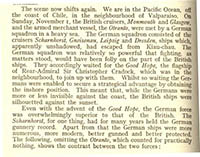

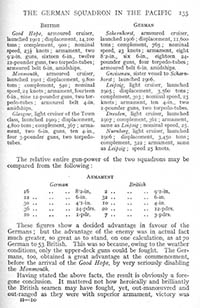
However, HMS Glasgow escaped and took the route through the Magellan Straits to arrive in the Atlantic to receive everlasting fame as being one of the chief protagonists in the destruction of all the German ships that were involved at the Battle of Coronel.
All that is now left for you to know, is that the German Admiral, Count Von Spee (after whom the pocket battleship in the River Plate drama was named, and, as she got her comeuppance in 1939 at the very beginning of WW2 so did the man himself at near to the beginning of WW1) took his ships, victors of Coronel, round the Cape Horn, into the Atlantic, and up to the Falkland Islands.
-----------------------------------------------
What follows is a story which may bring a tear to your eye. A tear of compassion? - certainly (even for Germans) but mainly a tear of pride in the sailors of the Royal Navy. Some of the story is plain 'Boys Own Stuff' especially for HMS Kent, but all of it is really what the Royal Navy has always been about.
The loss to Britain was slight, though any death brings profound grief to somebody, but the loss to Germany was immense both in lives and in ships and its people never really did get over it. Their admiral died and so too did his two sons plus another two thousand odd sailors and all their ships were destroyed. When you have read this page, perhaps you might like to read this one The Inevitable evil of submarine warfare. Together they paint a good picture of the suffering of the Germans from the naval perspective, where apart from the murdering crews of their UBoats (which brought perverse pleasure to the German people) they lunged from disaster to disaster in other naval matters, fooling themselves that events like Coronel were major German victories whilst full well knowing that they had destroyed a couple of old ships albeit manned by excellent men whose passing was greatly lamented in Britain. In 1916, when all else except for their pent up fleets in Cuxhaven, Wilhelmshaven, Bremmerhaven, Hamburg and Kiel had been taken from them, Jutland brought great joy for the German people, they seeing it as a total success and victory to them. It could be argued that the German navy faired a little better than did the British but neither side scored enough points to warrant a clear win. What the Germans didn't take into account about Jutland (but internationally, all others did) was that the Royal Navy had, with one or two lapses, barricaded them into their ports denying them the sea from 1914 until 1916 and continued doing it from 1916 until 1918 - that, in anybody's book, is a no win situation, a clear and unequivocal defeat, which added to all their other failures and defeats.
I would suggest that you read all the pages, but the LOGICAL start, leading from the last but one paragraph above..."All that is..." is on page 81 (4th page in from the left) starting with the first new paragraph ...."It was reported..." Enjoy the read - it is an amazing story. Incidentally, as our warship names are prefixed with HMS (old Commonwealth using the respective 'A', 'C', and 'NZ' after HM and before S {e.g.., HMAS for an Australian warships) German ship names were prefixed with SMS.
Now read this most exciting account of a naval battle against a German Fleet who were resoundedly beaten in WW1 losing all their ships bar one and well over 2000 men including the German Admiral and his two German officer sons, as against no British ship losses and, albeit it very sadly, eight repeat eight men. The German press, media (radio mainly), government, German ex pats living around the world, The Kaiser and German Royal Family members, and the German admiralty lost their heads in utter disbelief and temporarily their sanity all ranting and raving like lunatics. It was its very last fleet left roaming the oceans of the world free from the bond of captivity manifest in a total blockade of the German fleet in its ports after Jutland, by the might of the Royal Navy, which quite literally starved the nation to death forcing the German army in the field to surrender and the evil nation of Germany to plead begging fashion it to be allowed to sue for peace unconditionally. This humongous loss for the Germans occurred just weeks into the 1914-1918 World War
The first battle of the Falklands
The 1901 Portsmouth built heavy armoured cruiser HMS Kent a coal burner which was ordered by the CO to burn every bit of wood on board to keep up steam levels and thus the speed of the ship whilst running low on coal fuel whilst pursuing an enemy warship - that's ships boats, officer cabin furniture, ceremonial carved fittings, wardroom furniture, decks where practical, the only thing being spared was the Rum Tub. Bad for ship's company morale were that to be incinerated!
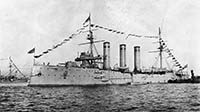
Her vital statistic were impressive for a cruiser, which were:-
Displacement 9800 long tons (each at 2240 lbs the normal way of differentiating between displacement and weight - the American tons and Metric tons are lighter), Speed 25 knots, 7" armour, 14 x 6" guns in total mounted alongside both port and stardboard sides 4 in 2 x double swivel pods below bridge and below main mast with single internal gun's midships just aft of centre funnel, plus two twin turrets one on fo'c'sle upper deck and one on quarterdeck upperdeck as standard 'A' and 'X'. In addition she had 8 x 12 pounder guns, where a 12 pounder (weight of shot or shell) equates to a 3.0" gun calibre, upper deck mounted, so in a mixture of combat ranges to target, say, 3 to 6 miles, 6000 to 12000 yards, she packed a punch which really did hurt!
You will have seen that only one of Count Von Spee's ships escaped from the British mauling, and that was the SMS Dresden. The history of the Falklands skirmish/sea fight (I would call it a Battle and none other) does not tell of the actual fate of the Dresden, which can be found later on in chronological order of the war calendar. However, to complete the story of the total and utter British victory over the German surface fleet units who were not bottled-up in German ports, I will add her destruction to this page. In some ways, her end was rather like that of the German pocket battleship Graf Spee in 1939, who sought a safe anchorage in neutral Uruguay, in Montivideo on the mouth of the River Plate, but under international rules, was forcibly sailed into what she thought was a large Royal Naval force and therefore chose the option of scuttling herself.
After her escape from the Falklands Sea Fight, she had headed back for Cape Horn and back into the Pacific Ocean. She travelled north, back to the area where the skirmish of Coronel had taken place, and there, just less than four hundreds miles from the city of Coronel, she found an anchorage in the Juan Fernandez groups of islands which belonged to Chile. Use this map to help you follow the story. The story is as follows:-
SMS Dresden Escape
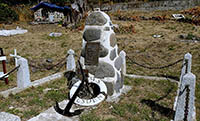
On the seashore there are graves of some of the crew of the German cruiser "Dresden", sunk in the bay in 1915. It is also the final resting place of Baron Alfredo de Rodt, who established the Island Community in 1877, residing there till his death.
Had the Germans not lost their entire Pacific squadron in December 1914 there would have been every chance of a German positive and unquestioned victory at Jutland 18 months later in mid 1916.
Below you will see firstly Admiral Graf Spee's WW1 flagship the Scharnhorst which with her sister the Gneisenau were sunk after the Royal Navy had discharged a combined total of 1174 shells during a running battle in the vicinity of the Falklands - page 99 of Battleships and Battlecruisers by Richard Humble (1983), followed by a German memorial montage of Spee and his destroyed squadron, put to the sword by Admiral Sturdee commanding the British Squadron. Spee died in his flagship losing also two sons in other lost ships.
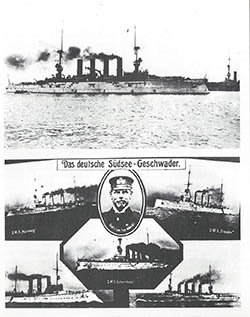
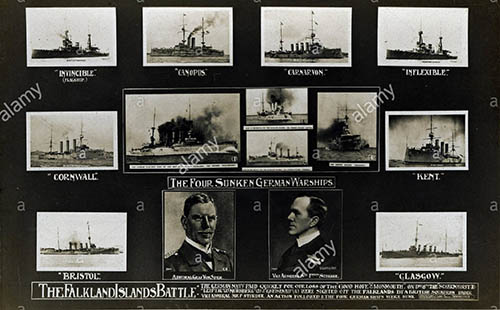
The image on the left is the German Memorial on the Falkland Islands and it reads 'The German South Pacific Squadron'. The image on the right is a British picture to celebrate some of the German Squadron sunk by Vice Admiral Sturdee including the picture of Admiral Graff Spee lost with his two sons and eventually other ships pursued to their destruction by the splendid Royal Navy!
And finally a small 'snippet' regarding HMS KENT
I read recently a website which told the story of the HMS Kent which was heavily involved in what was to become known as ?The battle of the Falkland Islands? during WW1, which stated that it quoted from the Commanding Officers diary for its story. Some time ago I had written an account of all the ?fights? of the British versus the Germans navies in the South Atlantic and in the Pacific Ocean in WW1 (excluding single ship altercations), and simply wanted to see what competition I had on the Internet.
The CO?s story was told (or quoted) in isolation to other stories and official reports from this fight, so I decided to look for more independent data published from other sources which covered this extremely important naval action and specifically the part played in it by the Kent, and that, for just one engagement, namely that against the German cruiser SMS Nuernberg. If nothing else, the CO states that some artefact made of wood was broken up and burned as fuel as a replacement for a shortfall of coal. Those relatively few pieces would by themselves, not have fed the fires adequately to produce the power needed to overhaul Nuernberg. Thus, notwithstanding the quoted CO?s diary, the story from the source below sounds much more realistic and plausible.
What I found, read as an exciting boy?s own type of story, worthy of being told and retold over and over again.
After WW1, in the 1920?s, many books were written about the war years of 1914 to 1918 and some were acknowledged as being authoritative, subsequently to be universally used as books of reference. One such publisher, Caxton Publishing Company of London, produced a series of large Volumes (1-10) called the ?the History of the Great European War ? Its causes and effects? which was compiled by W. Stanley Macbean Knight, assisted by eminent naval and military experts. In Volume 4 Chapter XXV, the story of this fight is told.
To understand this verbatim quote, one must first know about the Battle of Coronel (on the Pacific side of South America {on the Chilean coast}) and how the German Navy defeated the British Navy. This can be read above and in case you skipped by it, you can read the story here SMS Dresden Escape ? it will not take one long to read the salient parts of the story !
I begin. Quote......
While Glasgow and Cornwall were pursuing Leipzig, Kent had been ordered as from half-past three to engage Nuernberg, which was the nearest to her. Nuernberg evidently hoped to get away like the Dresden, and, as a matter of fact, had a very good chance of doing so, for Kent, was woefully short of fuel. The captain however ordered the boats to be broken up and fed into the furnaces.
The order was obeyed, the boats were broken up, smeared with oil, and passed into the furnaces. After them went the wooden ladders, the doors, and the chests of drawers from the officers? cabins.
In this way Kent was able to get up a speed of 24 knots. Kent?s pursuit of Nuernberg and their running fight lasted about four hours. It was at 7.27 that, blazing fore and aft, the German cruiser went down with her guns still firing. The Kent sailors were able to rescue seven of her brave crew. To this bravery one of the officers on the Kent bears striking testimony.
?They were a brave lot? he writes; ?one man stood aft and held the ensign flying in his hands until the ship went under.?
Kent lost four men killed and twelve wounded, and but for the heroism of Sergeant Charles Mayes might have been entirely lost with every man onboard her. His action is thus recorded:
?A shell burst and ignited cordite charges in the casement, and a flash of flame went down the hoist into the ammunition passage. Sergeant Mayes picked up a charge of cordite and threw it away. He then got hold of a fire hose and flooded the compartment, extinguishing the fire in some empty shell-bags which were burning?
For this brave act he was awarded the Conspicuous Gallantry Medal.
It was one single shell which caused most of the casualties on Kent, which did not get within range of Nuernberg until an hour and a half after the chase began. Firing went on from Nuernberg until half-past six, and then Kent ceased firing also, but as Nuernberg would not haul down her colours Kent opened fire again at a range of 3300 yards.
?Fire was finally stopped five minutes later on, the colours being hauled down, and every preparation was made to save life.?
This was not much , for it will be remembered that Kent had burned her boats after her coal had run short.
?We do what we can with life-buoys and lumps of wood paid astern, but it?s mighty little; it?s loppy sea and dreadful cold. The ?mollyhawks? are swooping around, and the vultures of the sea, the Albatrosses, are attacking the drowning German sailors seeking to peck out their eyes.?
Unquote.
This concludes the specific QUOTE on Kent?s engagement. However, and in context, a new Quote starts below.
Quote.....
Von Spee?s (the German admiral) delay cost him his entire squadron with the exception of one unit (Dresden, although she was later destroyed), the loss of his life and that of his two sons and over 2000 Germans, against seven or eight British killed and four wounded.
The outburst of fury in Germany when the news became generally well known, which was not for a considerable time after the event, was unparalleled. Some of the comments in the German papers read like the ravings of paranoiac. And the fact is that the Battle of the Falkland Islands dealt a terrible blow to Germany?s position as a naval Power. It wiped out the only Squadron she had left, outside the fleet buried in the Kiel Canal, and removed all danger to British trade routes. The work was complete when Bremen disappeared, and Dresden and Karlsruhe amongst cruisers, and Kronprinz Wilhelm and Prince Eitel Friedrich, were successively disposed of.
So great was the German fury that even the cool and cautious heads of the German Admiralty seemed temporarily to have lost all self-control. There can be no doubt that the attack on our East Coast on December 16 was by way of retaliation , a foolish act dictated by spite rather than by policy.
This morning a German cruiser force made a demonstration upon the Yorkshire coast, in the course of which they shelled Hartlepool, Whitby and Scarborough. A number of their fastest ships were employed for this purpose, and they remained for about an hour on the coast. They were engaged by patrol vessel on the spot. As soon as the presence of the enemy was reported a British patrolling squadron endeavoured to cut them off. On being sighted by British vessels the Germans retired at full speed, and favoured by the mist, succeeded in making good their escape.
A number of civilians, mainly women and children, were killed on this occasion by the German squadron. It was a pitiful revenge for the defeat off the Falklands.
Much of Germany's latest naval activity, which has been limited to submarine work, has been even more pitiful.
Unquote
This is a story which all RN Sailors, past and present, Officer or Rating, should know about. It cannot of course be compared with the 1982 Falklands War, which will be remembered as much for the logistics of war as for the GUTSY and successful prosecution of the war. Nor do I seek to sideline the 1982 war in any way, for it is part of my heart and life, but, the truth is that the first R.N. Battle in the waters of the Falklands has no parallel or precedent.
This first section is really an introduction to the main story which starts further down the page. It should be read first so that you get a good understanding of the true significance of the main story.
Today's date is the 4th July 2004, a day/date which sees the Americans celebrate the winning of the War of Independence against the British in the latter part of the 18th century. Twenty two years ago, this day was one of several used in the Spring/Summer offensive of 1982 pursing the War against the Argentine who had forcibly taken the Falkland Islands from the British, the rightful owners. It was a splendid time in our recent history engulfing all of us serving in the navy at that time in many various ways, and can of course also be considered as a War of Independence fought for and on behalf of the Crown and the peoples indigenous to the Islands. On this occasion, the British were the victors.
In some cases, the subject is still quite raw and so much has been written and recorded for posterity that additional articles are quite superfluous. However, the other day I came upon a statistic which stunned me and I am sure it will you too, namely that the known data of 255 men losing their lives in this war, has been surpassed by 300 Falklands veterans who have committed suicide between 1982 and 2004. There are no words which can measure the profoundness of this tragic statement.
The 1982 story of the Falklands really starts with an observation made by HMS Endurance (Captain Barker R.N.), the only Royal Naval ship stationed in the South Atlantic. This led to a large naval unit being formed whose logistics stretched seven thousand miles from the UK. A battle ensued between the Royal Navy and the Argentine air force which bloodied the nose of the Royal Navy, losing several ships. The Argentine navy never saw or engaged the main task force but was itself attacked by a British nuclear submarine, Conqueror (Commander Wreford-Brown R.N., - international radio callsign GYJU)), whilst at sea to the west of the Royal Navy's presence. The attack destroyed an old WW2 ex USN cruiser, the General Belgrano {international radio callsign LORH} with considerable loss of life. Thereafter, the Argentine navy remained in harbour. The navy punched its way through and managed a successful amphibious assault on the Islands, losing more vessels in the process. The land war was short and decisive culminating in the defeat and humiliation of the mainly conscript Argentine army units. However, it was expensive, the cost being two hundred and fifty lives of our servicemen and many many more Argentine's. However, even our most sternest critics, marveled at our ability to mount such an operation over such huge distances and win, though bloodied we were.
Way back in 1914 (90 years ago) and still down off South America but on the Pacific Chilean coast line, we were again bloodied, this time by the German navy. However, to understand the story properly, for it is interwoven through many reference books, I need to tell you a little bit about Germany's territory outside the Vaterland (fatherland).
In 1898 Germany had leased from China for a period of ninety nine years (by diplomatic deceit) a tiny insignificant area/port in the far east, which itself was part of the Chinese province of Shantung situated in the Yellow Sea. The area/port was called Tsing-Tau a naval facility in the Kiau-Chau Bay: it is this latter name which history recognises. Kiau-Chau was the original base for the German Raider Emden which was destroyed by HMAS Sydney. China has undergone many changes since the Boxer Uprisings (prior to this event) and with cultural changes came name changes of their provinces, towns and cities. To help you orientate, the first image is a map of China in 1900 biased towards Kiau-Chau and the second image is of a modern map of china annotated in a similar manner.


Germany's aggression was legion in all parts of the world, and the Japanese feared that they would get up to their usual evil tricks, even though relatively small in numbers and facilities. The Japanese, being our ally, issued the KIAU CHAU camp an ultimatum which was that they should clear out of China and take all their warships out of the Pacific/Far East area. Germany had to comply by 3am London time on 23rd August 1914 or face direct war with Japan, just 500 odd miles away to the east. Germany had several overseas possession, but cherished this one above all others - it was 117 square miles with a fine harbour and fortified town, and since 1898 (sixteen years) had lavished untold amounts of money on building it up ready to use as a spring board to increase a foot hold in the Far East : they were not going to move. It was also known, though as yet unchecked by the Chinese, that Germany had already broken the lease agreement by taking over more Shantung territory than was intended. Kiau Chau was full of Germans and not just combatants, for many had fled there escaping the consequences of war in other parts of the Far East. They had an "Eastern Squadron" based there which comprised of two armoured cruisers, three light cruisers and some gunboats. Had hostilities broken out, she faced unimaginable odds with Britain's Far East Squadron being twice that size; the French with two armoured cruisers, Japan with at least twenty eight large battleships and cruisers including five Dreadnoughts, several flotillas of destroyers and submarines, plus the Russian input all ready for the kill. Germany had no submarines at Kiau Chau but were ready to mine every conceivable approach to their territory.
Predictably, Germany did not comply with the Japanese ultimatum. How could the Kaiser, who, upon taking on the lease, proclaimed to the world the infamous observation about the "mailed fist of Germany"; "that we are descendants of Attila and his Huns", and that "the time had come for the great German eagle to spread her wings," now back down to Japan?
Directly after the hour of compliance had elapsed, the Japanese navy started to bombard Kiau Chau. However, by that time a British ship, the destroyer HMS Kennet, had had an adventure in the neighbourhood of the Tsing-Tau forts when it sighted a German destroyer the 'S.90'. The Kennet gave chase but the destroyer escaping back to the safety of Kiau Chau brought the British destroyer too close to the German guns placed on the forts and had to allow the German to escape. The Kennet took several casualties.
After a great deal of effort in clearing mines and other preparations (which included a one hundred percent blockade of the port), of daily shellings, of aircraft bombings, of stormings by amphibious troops landing behind German lines (remember this territory is 117 square miles - a big area) which lasted for seventysix days after Japan had declared war, the forts and area of Tsing-Tau capitulated and the white flag was raised by the Germans. Four thousand and forty two Germans were taken prisoner, with nearly as many killed. Japan lost two hundred killed and the British, just twelve. The Kaiser and the whole of Germany were shattered and found it difficult to believe this severe loss of life, of equipment and of territory. The Japanese took command of Kiau Chau.
Germany continued to lose all her Pacific territories, one by one snatched from her by the Royal New Zealand Navy, the Royal Australian Navy, the British Navy and the French Navy. What armed cruisers had been based on many of these places escaped into the Pacific, and they, plus those who escaped from Kiau Chau, were always a potential hazard to the allies. It is to those 'roaming' German ships that I now turn my attention.
A group of heavily armed German cruisers, unshadowed and thought to have escaped from Kiau Chau before the Japanese hostilities began, out to disrupt allied shipping traffic, had crossed the Pacific on a south easterly course, ostensibly aiming for the Cape Horn area and rich pickings! When off Valparaiso, Chile, they came across an inferior British naval group comprising of two cruisers and an armed merchant ship. These were HMS Monmouth and HMS Glasgow plus the 'Otranto'. The resulting battle was a foregone conclusion as shown in the following pages.



However, HMS Glasgow escaped and took the route through the Magellan Straits to arrive in the Atlantic to receive everlasting fame as being one of the chief protagonists in the destruction of all the German ships that were involved at the Battle of Coronel.
All that is now left for you to know, is that the German Admiral, Count Von Spee (after whom the pocket battleship in the River Plate drama was named, and, as she got her comeuppance in 1939 at the very beginning of WW2 so did the man himself at near to the beginning of WW1) took his ships, victors of Coronel, round the Cape Horn, into the Atlantic, and up to the Falkland Islands.
-----------------------------------------------
What follows is a story which may bring a tear to your eye. A tear of compassion? - certainly (even for Germans) but mainly a tear of pride in the sailors of the Royal Navy. Some of the story is plain 'Boys Own Stuff' especially for HMS Kent, but all of it is really what the Royal Navy has always been about.


